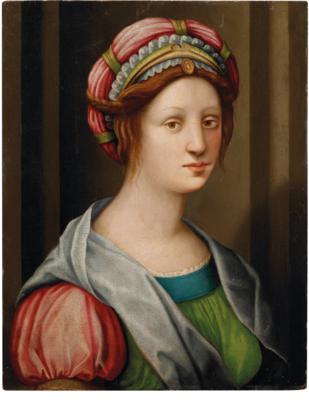Antonio di Donnino del Mazziere
(Florence circa 1490–1547)
Head of a woman: a testa ideale,
oil on panel, 64 x 50 cm, framed
Provenance:
Private European collection
We are grateful to Julianna Ágoston for suggesting the attribution on the basis of a photograph.
The present painting depicting a woman, with braided hair wearing a colourful headdress and gown, is an example of an ‘idealised head’ or ‘testa ideale’, a subject popular in the late sixteenth-century Florence. It has been suggested that these heads were not intended to show a specific sitter, but were instead used as representations of female beauty.
Michelangelo drew a number of similar Teste including Zenobia, conserved in the Gabinetto Disegni e Stampe in the Galleria degli Uffizi, Florence (see A. Alberti, A. Rovetta, C. Salsi, D’aprés Michelangelo, Venice 2015, pp. 63–66). Although this sophisticated and refined drawing shows the subject of the Queen of Palmyrene Empire in Syria, it was meant by Michelangelo to be perceived in a more general and abstract sense, as an idealised form.
Antonio di Donnino del Mazziere came from a family of artists. His uncle, Agnolo del Mazziere, worked with Michelangelo in 1507–1508 in Rome. His father, Donnino, collaborated with Agnolo in his workshop. It is therefore uncertain if Antonio began his career as an artist in his family’s workshop or rather as a pupil of Franciabigio, as Vasari stated (see G. Vasari, Lives of the Painters, Sculptors and Architects, vol. II, London 1996, p. 923). He was celebrated in Florence for his landscapes and depictions of horses. There are few traces of his works as many have been lost or destroyed.
Specialist: Mark MacDonnell
 Mark MacDonnell
Mark MacDonnell
+43 1 515 60 403
mark.macdonnell@dorotheum.at
15.12.2023 - 16:13
- Estimate:
-
EUR 10,000.- to EUR 15,000.-
- Starting bid:
-
EUR 10,000.-
Antonio di Donnino del Mazziere
(Florence circa 1490–1547)
Head of a woman: a testa ideale,
oil on panel, 64 x 50 cm, framed
Provenance:
Private European collection
We are grateful to Julianna Ágoston for suggesting the attribution on the basis of a photograph.
The present painting depicting a woman, with braided hair wearing a colourful headdress and gown, is an example of an ‘idealised head’ or ‘testa ideale’, a subject popular in the late sixteenth-century Florence. It has been suggested that these heads were not intended to show a specific sitter, but were instead used as representations of female beauty.
Michelangelo drew a number of similar Teste including Zenobia, conserved in the Gabinetto Disegni e Stampe in the Galleria degli Uffizi, Florence (see A. Alberti, A. Rovetta, C. Salsi, D’aprés Michelangelo, Venice 2015, pp. 63–66). Although this sophisticated and refined drawing shows the subject of the Queen of Palmyrene Empire in Syria, it was meant by Michelangelo to be perceived in a more general and abstract sense, as an idealised form.
Antonio di Donnino del Mazziere came from a family of artists. His uncle, Agnolo del Mazziere, worked with Michelangelo in 1507–1508 in Rome. His father, Donnino, collaborated with Agnolo in his workshop. It is therefore uncertain if Antonio began his career as an artist in his family’s workshop or rather as a pupil of Franciabigio, as Vasari stated (see G. Vasari, Lives of the Painters, Sculptors and Architects, vol. II, London 1996, p. 923). He was celebrated in Florence for his landscapes and depictions of horses. There are few traces of his works as many have been lost or destroyed.
Specialist: Mark MacDonnell
 Mark MacDonnell
Mark MacDonnell
+43 1 515 60 403
mark.macdonnell@dorotheum.at
|
Buyers hotline
Mon.-Fri.: 10.00am - 5.00pm
old.masters@dorotheum.at +43 1 515 60 403 |
| Auction: | Old Master Paintings - Including works from the Rimpau-Langenstein collection (Lots 108–139) |
| Auction type: | Online auction |
| Date: | 15.12.2023 - 16:13 |
| Location: | Vienna | Palais Dorotheum |
| Exhibition: | 07.12. - 14.12.2023 |

